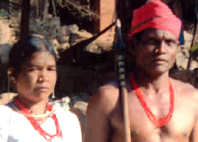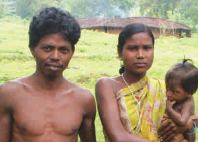Cultural Festivals
Tribal festivals have religious origins and entwines cultural and...
View moreThe Council will take up with the following objectives:









Skills are never taught they are acquired. Importance given to skill...
View more
A PVTG of Odisha.

Location : Gajapati, Rayagada (Eastern Ghats Region)
Language: Austro-Asiatic / Munda
Occupation: Icon (wall painting), Wood carving, Stone Terracing & Water management, Cashew plantation & processing
Techno-Economic Stages: Shifting Cultivators
Lanjia Saora constitute one of the primitive section of Saora tribe. They are called so by their neighbours for their distinct dressing pattern which is a loin cloth hang in fron and tail like tails (Lanja). The traditional dress of a Saora women is a traditional coarse waist cloth. In chilly weather they cover their upper body with another cloth. Saora women do not use too many ornaments. The women greatly enlarge their ear lobes to wear wooden ear plugs and have a characteristic tattoo in the middle of the forehead. The Lanjia Saoras have a shattered type of housing pattern in the hill slope. They install the village guardian deities represented by wooden posts in the entrance of the village. They pursue shifting cultivation and ingeniously prepare stone bounded terrace fields with inbuilt water management systen for paddy cultivation. They have no clans but lineage organisation called as Birinda. They have their male and female samans to fulfill their magico-religious needs. They are famous for their attractive wall painting called idital.
A PVTG of Odisha.

Location : Sundargarh, Angul, Deogarh (Northern Plateau Zone)
Language: Indo-Aryan
Occupation: Broom stick making, Broom stick making, Mat making, Basketry, Litchi cultivation, Tussar rearing
Techno-Economic Stages: Shifting Cultivators
The Paudi Bhuyan are a major section of the Bhuyan tribe which are found in Bihar, West Bengal, Assam and Bihar. The Paudis mostly inhibit geographically isolated areas like thick forest and hill slopes. They speak local Odia with a different accent. They practice slash and burn type rotation cultivation. They carry on food gathering and hunting in the forest. {The youth dormitory "Darbarghar" is built at the center of the village for unmarried boys. The unmarried boys keep their Changu hung on the walls and grains are ept on a raised platform in the corner of the dormitory. Mostly 5 to 20 families constitute a village. The Paudis keep their houses neat and clean plastered with cow dung and red earth. Each family maintains a kitchen garden. The house is divided into three sections with the inner section being used to store grains, middle for cooking and sleeping. Paudi Bhuyans mainly use earthen vessels, palm leaf mats and bamboo baskets. The patch unde shifting cultivation is known as Biringa. Pulses, Millets are grown in various years. After the land is left fallow it comes under the control of the village. The livestock of the Paudi Bhuyan consists of cow, buffalo, goat, sheep, fowl etc. They are not good in trading hence they exchange their agricultural and forest produce for their daily necessities.